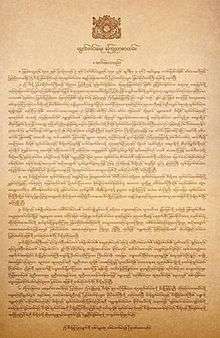Burmese Declaration of Independence
The Burmese Declaration of Independence (Burmese: လွတ်လပ်ရေးကြေညာစာတမ်း) was officially promulgated on 4 January 1948, marking the end of British rule in Burma (now Myanmar). The date is now celebrated as Independence Day, a national gazetted holiday. The document was jointly penned by Zawgyi, Min Thu Wun, Ohn Pe and Win Sein, and translated into English by Maung Maung,[1] U Thant, Khin Maung, and Khin Zaw.
| Declaration of Independence | |
|---|---|
 | |
| Original title | လွတ်လပ်ရေးကြေညာစာတမ်း |
| Date effective | January 4, 1948 |
| Location | Rangoon, Burma (now Yangon, Myanmar) |
| Author(s) | Thein Han, Min Thu Wun, Ohn Pe and Win Sein |
History
The Declaration of Independence was preceded by another Declaration of Independence, signed by Ba Maw on 1 August 1943.[2] During World War II, the Japanese government advanced its previously vague promise to grant Burma independence after the end of the war.[3] The Japanese felt that this would give the Burmese a real stake in an Axis victory in the Second World War, creating resistance against possible re-colonization by the western powers, and increased military and economic support from Burma for the Japanese war effort. A Burma Independence Preparatory Committee chaired by Ba Maw was formed 8 May 1943 and the nominally independent State of Burma was proclaimed on 1 August 1943 with Ba Maw as "Naingandaw Adipadi" (head of state) as well as prime minister.
References
- Taylor, Robert H. (2003-08-01). Dr Maung Maung. Flipside Digital Content Company Inc. ISBN 9789814515863.
- "Dr. Ba Maw Library - Statements". www.drbamawlibrary.org. Retrieved 2018-09-27.
- John Toland, The Rising Sun: The Decline and Fall of the Japanese Empire 1936-1945 p 456 Random House New York 1970